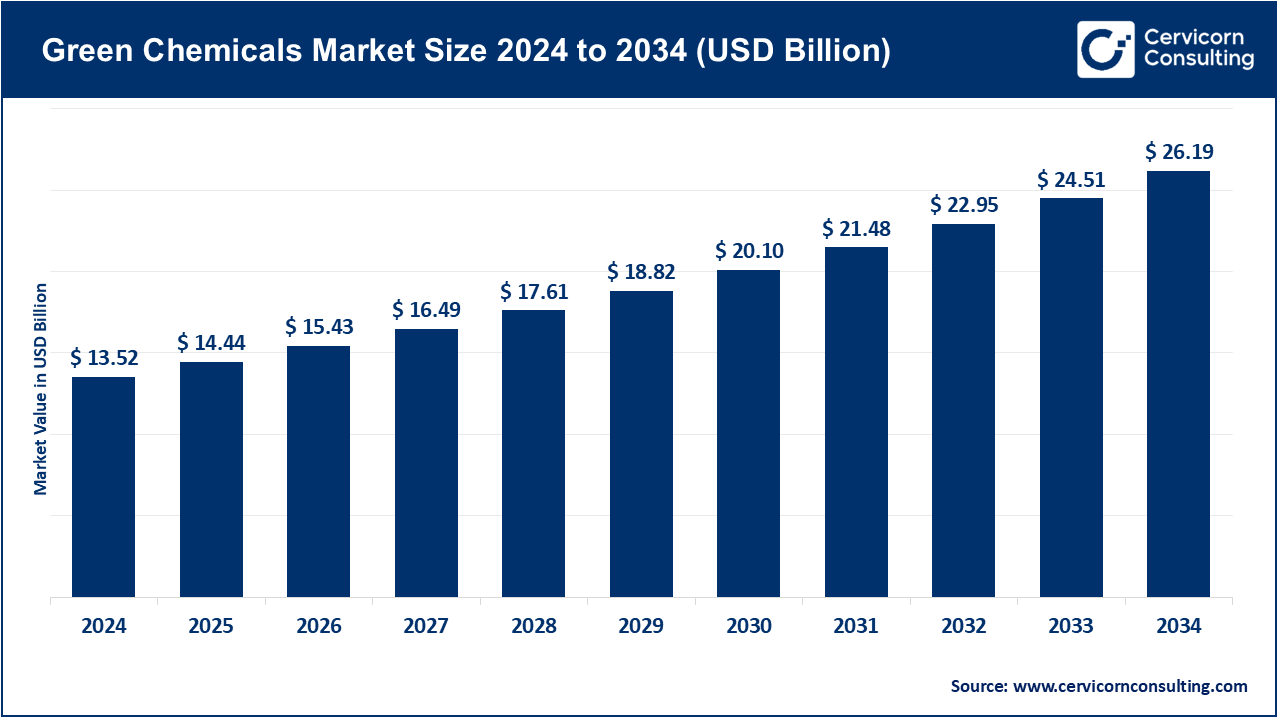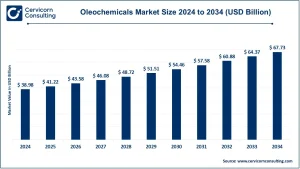Green Chemicals Market Overview
The global green chemicals market is reshaping the traditional chemical sector by providing eco-friendly alternatives to conventional petrochemicals. The market was valued at USD 13.52 billion in 2024 and is projected to climb to USD 26.19 billion by 2034, registering a CAGR of 6.84% between 2025 and 2034. Often referred to as bio-based or sustainable chemicals, these products are sourced from renewable feedstocks such as plant sugars, vegetable oils, and agricultural residues, or manufactured through energy-efficient, low-emission processes. Their portfolio spans biopolymers, bio-based solvents, surfactants, intermediates, and specialty chemicals—helping industries cut emissions, comply with stricter environmental rules, and satisfy consumer demand for greener products.
Key Market Trends
1. Transition to Bio-Based Feedstocks
Industries are increasingly replacing fossil-derived raw materials with sustainable inputs like starch, sugar, and vegetable oils. Breakthroughs in enzyme and fermentation technologies have boosted the production of green intermediates and polymers. For example, polylactic acid (PLA), widely used in compostable packaging, is experiencing rising adoption in both consumer and industrial applications.
2. Circular Economy & Biodegradable Solutions
The global shift toward circularity has accelerated investment in biodegradable plastics and recyclable formulations. Regulatory bans on single-use plastics are fueling the uptake of compostable packaging. Companies such as Corbion and BASF are investing heavily in biodegradable polymer production to align with sustainability requirements.
3. Policy Push & Carbon Regulations
Carbon pricing, plastic taxes, and emissions reduction targets are encouraging industries to transition to renewable chemicals. The European Union continues to lead with robust regulations, creating strong momentum for green chemical adoption.
4. Technological Breakthroughs in Green Chemistry
Advances in catalysis, bio-refining, and process electrification are helping reduce costs while scaling production. These innovations improve efficiency and enhance competitiveness with conventional petrochemical alternatives.
5. Shifting Consumer Preferences
With sustainability becoming a lifestyle choice, demand for renewable-based personal care, food, and household products is climbing. Corporate ESG commitments and growing investor focus on decarbonization further amplify this trend.
Market Drivers
-
Rising Demand Across Sectors: Packaging, agriculture, food & beverage, and personal care are among the largest adopters, with bio-based polymers projected as one of the fastest-growing product segments.
-
Supportive Government Policies: Regulations such as plastic bans, feedstock subsidies, and emission standards are creating favorable conditions. Europe and Asia are leading this regulatory-driven shift.
-
Advancements in Bio-Refineries: Declining costs and improved efficiency in bio-refinery operations are driving wider adoption of green chemicals, according to Cervicorn Consulting.
-
Corporate Sustainability Commitments: Large corporations embedding ESG goals are increasingly sourcing renewable raw materials, creating robust supply-chain partnerships.
-
Growing Consumer Awareness: Environmental concerns are prompting greater demand for biodegradable and renewable-based alternatives across multiple industries.
Impact of Trends & Drivers
-
By Segment: Biopolymers and biodegradable plastics are expected to experience the fastest growth, supported by plastic bans and sustainable packaging needs. Specialty chemicals in food additives and personal care also show rising demand.
-
By Region:
-
Europe holds the largest share, supported by strong regulatory mandates.
-
Asia-Pacific is forecast to grow fastest due to rapid industrialization, government initiatives, and expanding consumer markets.
-
North America is investing heavily in bio-refineries and strategic collaborations.
-
-
By Application: Packaging, agriculture, and personal care will be most affected by the dual forces of regulatory pressure and consumer preferences.
Challenges & Opportunities
-
Challenges: High production costs compared to fossil-based chemicals, feedstock supply constraints, and scaling difficulties remain barriers.
-
Opportunities: Expanding consumer preference for sustainable products, government backing, and falling bio-refinery costs open strong prospects for innovators and early adopters.
Future Outlook
The next decade will see rapid adoption of biodegradable polymers, bio-based intermediates, and circular process technologies. Tightening environmental rules, heightened corporate ESG commitments, and surging consumer interest in sustainable products will collectively accelerate innovation, commercialization, and mainstream integration of green chemicals globally.



